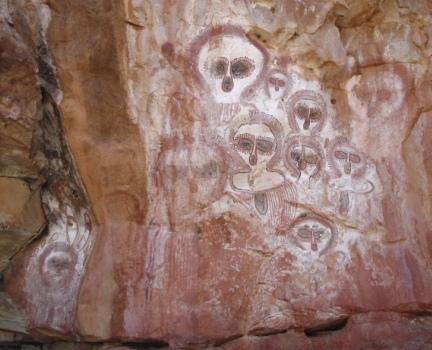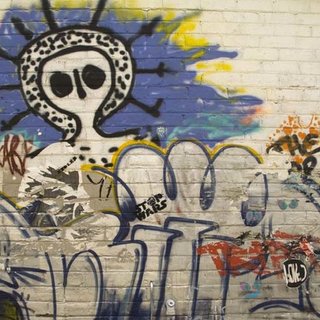By Maren Brophy, 9/30/022
History and Design
Dating back as far as when humans began to walk this earth, we have been inventing different ways to communicate and share ideas. From cave paintings to hieroglyphics, our desire to communicate has led to some of the most valuable pieces of history. Not only that, these artifacts are the basis for what design is today. I have been fascinated with paleolithic and neolithic history. Cave paintings are particularly interesting to me as they combine my love of prehistory with my interest in the evolution of communication. When I learnt about Wandjina I was instantly intrigued. The striking imagery of the paintings and the rich story behind the art instantly drew me to the topic. Images of Wanjina spirts are the oldest sacred paintings found on the planet to date. Found in the Kimberley region in Australia, these incredible pieces of art give us insight into the fundamental nature of humans and our desire to communicate.

Wandjina cave art in Kimberly WA, Australia. https://japingkaaboriginalart.com/articles/wandjina/
The History of Wandjina paintings
It is theorized that the rock paintings of the Wandjina located in Kimberley are roughly 4,000 years old. Stylistically, these rock paintings emerged due to a millennium-long drought which resulted in a wetter environment. Wandjina paintings are done in a variety of white, black, yellow, and red. The paintings are arranged either horizontally or vertically depending on the size of the rock and the spirits have been depicted in either groups or solo. Occasionally, they are portrayed with objects such as a Rainbow Serpent ( a deity seen as a creator god). The figures appear with huge eyes and a long nose and body, but no mouth.

The dots that are drawn on many Wandjina represent rainfall. https://aboriginalartshop.com/wandjina-rock-aboriginal-art/
Wandjina and Aboriginal Beliefs
Something that drew me to Wandjina as a topic for this post was how it is one of the first sacred images. It also has a rich story and mythology behind it. In the aboriginal Australian’s beliefs, the Wandjina is a shape-changing being which is associated with rain and fertility. Dreamtime legends (the term to describe the stories and beliefs of the Aboriginal Australians) state the Wandjina are the ones who created the landscape and inhabitants and still have power over these elements. As for the cave paintings, is told that when spirits find a place to die, they put their images on the rocks and would leave the physical world through a nearby waterhole.
The Power of Design on Story and Symbolism
Design can be an impactful thing, and if done right, it can be truly timeless. Wandjina is a prime example of this. Something that surprised me about Wandijnas is that they are still revered by the Aboriginal tribes of the Worora, Ngarinyin and Wunumbul. This shows us the impact that these cave paintings had as the imagery and stories that they represented are still an important part of Australian Aboriginal culture today. These incredible images which provide insight into human history also demonstrate the power that the history of design has on art today. For example, the palettes used in Wandjina paintings are used today and their imagery even was said to inspire modern-day depictions of aliens. Wandjina cave paintings are an early example of the use of symbolism as many different aspects of their design communicate the stories behind these spirits. Diving into the art of the Wandjina cave paintings inspired me to think about using symbols and stories behind my design to give them another level of interest. Researching this topic showed me how powerful a design with meaning and a story can be and I am excited to keep learning about the history of visual communication.

Modern day street art of a Wandjina in Perth showing how the legend of the Wandjina has lived on and is still an important part of Australian culture. https://www.researchgate.net/figure/A-Wandjina-style-figure-amid-graffiti-in-Perth_fig3_242558094
References
Aldridge, R. (n.d.). Wandjina. aboriginal-bark-paintings.com. https://www.aboriginal-bark-paintings.com/wandjina/
Gillan, J. (2021, November 27). The Mysterious Aboriginal Rock Art of the Wandjina Sky Beings. Ancient Origins. Retrieved October 3, 2022, from https://www.ancient-origins.net/human-origins-folklore/wandjina-rock-art-00701
Korff, J. C. S. (2020, July 16). What are Wandjinas? Creative Spirits. Retrieved October 3, 2022, from https://www.creativespirits.info/aboriginalculture/arts/what-are-wandjinas
Plunkett, J. (2022, February 1). Wandjina Dreamtime Story. Japingka Aboriginal Art Gallery. Retrieved October 3, 2022, from https://japingkaaboriginalart.com/articles/wandjina/
Wroth, D. (2017). Aboriginal Rock Art of the Kimberley – An Overview.
japingkaaboriginalart.com. https://japingkaaboriginalart.com/articles/kimberley-rock-art-overview/